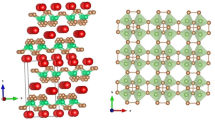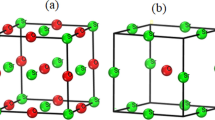Abstract
In the lattice energy expression of forsterite, based on a Born-Mayer (electrostatic+repulsive+dispersive) potential, the oxygen charge z o, the hardness parameter ρ and the repulsive radii r Mg and r Si appear as unknown parameters. These were determined by calculating the first and second partial derivatives of the energy with respect to the cell edges, and equalizing them to quantities related to the crystal elastic constants; the overdetermined system of equations was solved numerically, minimizing the root-mean-square deviation. To test the results obtained, the SiO 4−4 ion was assumed to move in the unit-cell, and the least-energy configuration was sought and compared with the experimental one. By combining the two methods, the optimum set of parameters was: z o=−1.34, ρ=0.27 Å, r Mg=0.72 Å, r Si=0.64 Å. The values −8565.12 and −8927.28 kJ mol−1 were obtained, respectively, for the lattice energy E Land for its ionic component E 0L ,which accounts for interactions between Mg2+ and SiO 4−4 ions only. The charge distribution calculated on the SiO 4−4 ion was discussed and compared with other results. Using appropriate thermochemical cycles, the formation enthalpy and the binding energy of SiO 4−4 were estimated to be: ΔH f(SiO 4−4 )=2117.6 and E(SiO 4−4 )=708.6 kJ mol−1, respectively.
Similar content being viewed by others
References
Born L (1964) Eine „gitterenergetisches Verfeinerung“ der freien Mg-Position im Olivin. Neues Jahrb Mineral Monatsh, pp 81–94
Born M, Mayer JE (1932) Zur Gittertheorie der Ionenkristalle. Z Phys 75:1–18
Boswarva IM (1970) Semiempirical calculations of ionic polarizabilities and van der Waals potential coefficients for the alkaline-earth chalcogenides. Phys Rev B: 1:1698–1701
Brown GE, Fenn PM (1979) Structure energies of the alkali feldspars. Phys Chem Minerals 4:83–100
Catti M (1978) Electrostatic lattice energy in ionic crystals: optimization of the convergence of Ewald series. Acta Crystallogr Sect A: 34:974–979
Catti M (1979) Second-neighbours contribution to the repulsive energy of crystalline alkaline-earth oxides. Solid State Commun 29:243–246
Catti M (1981) A generalized Born-Mayer parametrization of the lattice energy in orthorhombic ionic crystals. Acta Crystallogr Sect A: 37:72–76
Collins GAD, Cruickshank DWJ, Breeze A (1972) Ab initio calculations on the silicate ion, orthosilicic acid and their L 2,3 X-ray spectra. J Chem Soc Faraday Trans 2 68:1189–1195
Graham EK Jr, Barsch GR (1969) Elastic constants of single-crystal forsterite as a function of temperature and pressure. J Geophys Res 74:5949–5960
`t Hart J (1978) The structural morphology of olivine. II. A quantitative derivation. Can Mineral 16:547–560
Hazen RM (1976) Effects of temperature and pressure on the crystal structure of forsterite. Am Mineral 61:1280–1293
Jenkins HDB, Pratt KF (1978) Single ion properties by lattice energy minimization. The perchlorate ion, ClO −4 . J Chem Soc Faraday Trans 2 74:968–981
Johansen H (1974) SCF LCAO MO calculations for the iso-electronic series ClO −4 , SO 4−4 , and PO 3−4 . Theor Chim Acta 32:273–278
Kumazawa M, Anderson OL (1969) Elastic moduli, pressure derivatives and temperature derivatives of single-crystal olivine and single-crystal forsterite. J Geophys Res 74:5961–5972
Ohashi Y (1976) Lattice energy of some silicate minerals and the effect of oxygen bridging in relation to crystallization sequence. Carnegie Inst Washington Yearb 75:644–648
Pauling L (1927) The theoretical prediction of the physical properties of many-electron atoms and ions. Mole refraction, diamagnetic susceptibility, and extension in space. Proc R Soc London Ser A: 114:181–211
Raymond M (1971) Madelung constants for several silicates. Carnegie Inst Washington Yearb 70:225–227
Robie RA, Waldbaum DR (1968) Thermodynamic properties of minerals. Geol Surv Bull 1259:214
Singh HP, Simmons G (1976) X-ray determination of thermal expansion of olivines. Acta Crystallogr Sect A: 32:771–773
Tosi MP (1964) Cohesion of ionic solids in the Born model. Solid State Phys 16:1–120
Tossel JA (1975) The electronic structures of silicon, aluminum, and magnesium in tetrahedral coordination with oxygen from SCF - Xα MO calculations. J Am Chem Soc 97:4840–4844
Wallace DC (1972) Thermodynamics of crystals. Wiley, New York, pp 23–28
Yuen, PS, Lister MW, Nyburg SC (1978) The four-center charge distribution of the carbonate ion and the lattice energies of calcite and aragonite. J Chem Phys 68:1936–1941
Zen E, Chernosky JV (1976) Correlated free-energy values of antophyllite, brucite, clinochrysotile, enstatite, forsterite, quartz, and talc. Am Mineral 61:1156–1166
Author information
Authors and Affiliations
Rights and permissions
About this article
Cite this article
Catti, M. The lattice energy of forsterite. Charge distribution and formation enthalpy of the SiO 4−4 ion. Phys Chem Minerals 7, 20–25 (1981). https://doi.org/10.1007/BF00308196
Received:
Issue Date:
DOI: https://doi.org/10.1007/BF00308196




